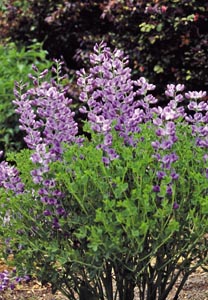12/15/2008
Propagation of Baptisia australis
Allen Bush
 Baptisia australis
Baptisia australis, a native North American species, is the Perennial Plant Association’s newly elected 2010 Plant of the Year and was previously awarded the Royal Horticultural Society’s Award of Garden Merit. The species grows over most of the eastern United States and Ontario. The smaller Baptisia australis var. minor is about half the size of the straight species and extends the plant’s range to Nebraska and south to Texas.
Commonly known as false blue indigo,
Baptisia australis grows 3 to 4 ft. tall with a slightly wider breadth. It develops an extensive root system that enables it to endure dry conditions, though it’s happy in any reasonably drained soils. The attractive blue-green leaves are highlighted in May and June with 12 to 18-in. flowering racemes carrying blue-purple lupine-like blossoms that work well as cut flowers.
Propagation
Seed propagation is the most economical propagation method, though tissue culture and tip cuttings are possible. Force cutting stock in winter to take cuttings between January and March. Once baptisia winter cuttings are rooted, they are able to build sufficient reserves to make it through the first winter more successfully than if they were taken later. When spring arrives, it’s often too hot for mist to cool the leaf surfaces.
Heavy flowering can’t be counted on until the third season, but if you begin seed production this winter, some flowers will result by spring 2010, when demand created by the PPA award kicks in. There are three methods to accomplish germination. The easiest and quickest method is with Jelitto’s Gold Nugget seed. These treated seeds can be ordered several weeks prior to sowing and germination will begin evenly over a period of two to three weeks with warm greenhouse temperatures of 68 to 75F (20 to 24C). Gold Nugget seed should always be sown within two to three weeks of receipt. Seeds can be sown into deep open flats or into 72 cells. Two to three seeds can be sown in each cell. We recommend using 40 grams of regular seed to produce 1,000 plants (70 seeds per gram) or 20 grams of Gold Nugget seed, one to two seeds per cell, to produce 1,000 plants (60 seeds per gram).
Other germination methods require extra steps, and more time (four to six weeks), but will result in similar germination approaching 75%. The difficulty is the seed coats; their hardness inhibits water and gaseous exchange through the tough membrane. Penetrating the seed coat is accomplished in nature by cold, moist conditions or shifting gritty soils that abrasively soften the seed coats. Before the introduction of Gold Nugget Seed, growers sowed seed and provided warm conditions for the first week, and then fluctuated cool temperatures in a range from 32 to 40F (0 to 4C) for three to four additional weeks. Greenhouse temperatures are then warmed to 68 to 75F (20 to 24C) and germination takes place irregularly over a three to four-week period. Seed flats shouldn’t be discarded because subsequent germination will occur after repeating the process.
An alternative hot water soak bypasses moist/cold stratification. Bring water to a boil, and then allow it to cool for five minutes. Soak the seeds overnight. Better results sometimes occur with a repeated soak. A downside to this method is subsequent machine sowing of soggy seeds and reduced germination percentage. Germination should occur within two to four weeks.
Within four to six weeks of germination, seedlings can be shifted into containers and grown on.
Baptisia australis is ideally suited for quart-size (4.5-in.) containers its first year. Plants will be ready for sale six to eight weeks following potting.
Allen Bush is director of special projects for Jelitto Perennial Seeds.